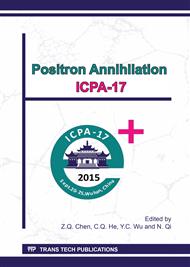p.75
p.80
p.84
p.91
p.96
p.100
p.104
p.108
p.113
PALS and TEM Study on Irradiation Defects of 12Cr-ODS Steels Induced by He/H Ions
Abstract:
The purpose of this study is to evaluate the irradiation defects of 12Cr-ODS steels induced by He/H ions, to provide basic understanding concerning development of fusion reactor components. Firstly, single He、H ion implantation and He/H ion co-implantation of 12Cr-ODS steels were performed at room temperature; and then SIMS were used to determine the He/H ion depth; finally, the irradiation induced defects were investigated by PALS and TEM. Characterization of the implanted samples with SIMS shows that He/H ions are mainly distributed at 4-6μm depth, consistent with the SRIM simulation. The PALS results show that the positron lifetime of H ions implanted samples increases slightly with increasing incident ions fluence, while for He and He/H ion implantation it is reversed. In addition, TEM results demonstrate that after irradiation, cavities are created in all samples, and He ion irradiation produce seriously larger damage compared to H ion. The positron lifetime results can be mainly ascribed to the difference of He and H ion interaction with defects.
Info:
Periodical:
Pages:
96-99
Citation:
Online since:
March 2017
Authors:
Keywords:
Price:
Сopyright:
© 2016 Trans Tech Publications Ltd. All Rights Reserved
Share:
Citation:


